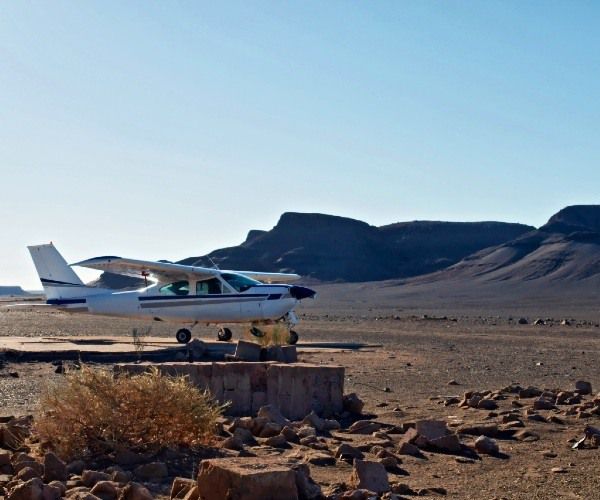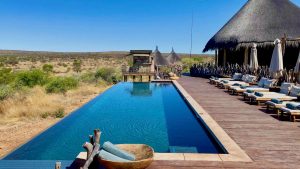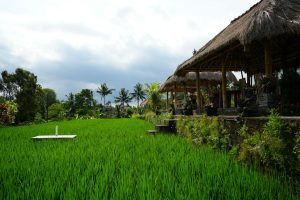
Namibia is a land of contrast, with landscapes ranging from the rusty coloured sand dunes of the Namib Desert, to the rocky Damaraland and the lush sceneries of the Caprivi Strip…
Etosha and the parks in the Caprivi Strip are great for game viewing, but Namibia is also home to some desert-adapted wildlife, such as the desert-adapted elephants, lions and the black rhinos, which roam freely outside of national parks. There is also the opportunity to experience cultural insights, from some of the different cultures.
All those activities and discoveries are traditionally part of a road trip, conducted either as a self-drive tour or as a guided tour. However, reaching those different sites by road is not the only option: fly-in safaris are also an excellent way to discover what Namibia has to offer, hoping from lodge to lodge in a small aircraft. It is understandably more expensive than travelling by road, but it has some definite advantages. Let’s look at why this way of transportation is ideally suited for Namibia:
You can avoid the (sometimes long) road
Namibia is the second least densely populated country in the world, where 2.5 million inhabitants are spread over 824,292 km2 (that’s 3.4 times the size of UK!). Spanning about 1300 km from North to South, and 1400 km from West to East (along the Caprivi Strip), it is a huge country. The different interesting sites are usually located quite far apart, and there is often plenty of empty areas to cross, which can be monotonous.

Therefore, reaching your next accommodation by plane is ideal for saving you many hours of travel time and avoiding lengthy road travel.
You can reach more secluded and less frequented areas
By air, you can also reach places that are difficult to access on the ground. The remote North-West of Namibia, including the Skeleton Coast and the Kaokoland (now part of the Kunene region), includes some restricted areas and is difficult to access as there are only a few tracks. Travelling by light aircraft can take you to the places most untouched by tourism.

You can travel with only a few days available:
When time is of the essence, you can easily visit different eco-systems that are far away from each other. You can include only the places that are of interest to you, without having to add some additional nights for stops in between, due to the road being too long to be covered in one day.

To experience flying in a small aeroplane
Flying in a light aircraft, such as a Cessna 210, is an adventure in itself. It has nothing to do with a commercial aeroplane. You can experience firsthand the work of your pilot, which is always an interesting thing to witness. Furthermore, flying in a light aircraft, you are also much more in touch with nature. You may for example feel the winds and even some bumpiness, which is totally safe of course. But it is fascinating to realise you are going along with nature, instead of fighting against it. In the rainy season, curious travellers have the opportunity to spot the clouds formation, compared to a bigger aeroplane flying at a higher altitude, where you fly above the clouds and cannot really see how they spread. Overall, it is an experience in itself, which is comparable to none other.

The flexibility it affords you
Due to a reduced travel time (compared to driving), you have more flexibility when flying in a private charter aircraft. For example, you may want to sleep a bit later one morning, and depart an hour later to your next destination: you may still be able to make it in time for your afternoon activity. The time it saves compared to road travel is time that can be used in a flexible manner, to make your trip a more enjoyable one.

Sightseeing from a bird’s eye view
The world-famous photographer Yann Arthus-Bertrand popularized aerial landscapes with his book called “The Earth from the Air” two decades ago. Who hasn’t dreamed to experience such wonderful and picture-perfect landscapes with your own eyes? From the organization of a Himba village, with the location of its huts and its central kraal (where the cattle is kept), to the Kuiseb River stopping the progression of the Namib Desert red sand to the North, offering contrasting landscapes on both sides of the river, to the Edouard Bohlen shipwreck, laying down on the sand, the sights to experience are endless!

You may also gain a different perspective of the same site, by visiting it both from the ground and from the air. Seeing the dark dead trees of Deadvlei contrasting with the background made of red dunes and the white pan, is a sight to behold. But seeing it from the sky, in the middle of the vast Namib Desert, gives it a totally different dimension.
All you need to do is sit back, relax and enjoy your flight!






